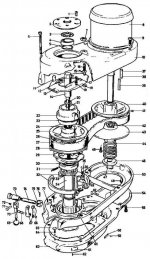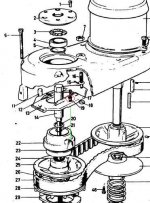awake
Titanium
- Joined
- Jan 24, 2006
- Location
- Angier, North Carolina
In an earlier thread, you all (and the outstanding folks at H&W) helped me get my recently-purchased BP with 2J2 head running smoothly. Since then I have only had bits and pieces of time to do some additional fine-tuning.
One thing that I was pretty sure needed adjustment was the speed setting - based on the "feel" and how cutters were cutting, plus the fact that the speed setting screw was all the way out (I left it where it was set when I got the machine), I suspected that the speed was significantly off as compared to what it showed on the dial. I finally got an inexpensive laser tachometer, tested it against various spindles and rotating objects with a known speed - seems pretty accurate across a broad range, certainly within a few rpm - then I tested the BP spindle. Turns out the BP spindle was turning nearly twice as fast as what the dial said! My lowest speed in the high range was not 500, but around 975 rpm.
No problem, right? Just loosen the locknut and adjust the screw. Well ... problem. I had to turn the adjustment nearly all the way down to get the speed down to 500 (and likewise to 60 in back gear) - but at that point, I'm getting a scraping sound; I'm still trying to figure out a way to see what's going on while the machine is running (hard to see when the head is assembled!), but presumably either the yoke is scraping against the pulley, or maybe the belt, being squeezed out to the maximum possible, is rubbing against the adjusting chain - ? While I was contemplating whether I could live with that, and/or how to create clearance, I tested the higher speeds. Oops - it ran smoothly from 500 up to around 2000, but then further adjustment had no effect. Even though the dial turns, and the chain loosens, it seems as though maybe the yoke just can't tilt any further, or something else prevents it from moving any further. For what I do, 2000 would be plenty of speed at the top end ... but here's the problem: This means that in back gear, it tops out at 200 or so rpm - leaving me with a gap from 200 - 500 rpm.
I've tried adjusting the speed adjustment screw in various ways, hoping to at least wind up with something close-but-usable (knowing I could rotate the dial to try to compensate) - but so far, unless I adjust it way back up (way over speed), I seem to "top out" at some point, and thus have a gap in my speed ranges. I wonder if the shop I bought it from intentionally set it up at approximately 2x speed, and just calculated the actual speed accordingly - ?? However, this would mean the lowest speed would not be 60 rpm, but 120. Maybe I don't need 60 rpm ... ?? But ideally I sure would like to have the stated range of 60 - 3000+ rpm.
One obvious question is whether the motor is turning the right speed. That brilliant thought didn't occur to me until I was typing this - so I will try to get out and check that sometime today. But it does appear to be the correct, original motor, and at least visually it doesn't look like it is spinning 2x too fast. And yes, it is properly wired for the 240v 3 phase that it is receiving. (And even if not wired correctly, the wrong voltage should not change the rpm, but just fry the wiring, right?)
So ... is this a common issue with this head? Are there any brilliant solutions? Maybe something in the chain or yoke attachment or something like that needs to be adjusted ... ??
One thing that I was pretty sure needed adjustment was the speed setting - based on the "feel" and how cutters were cutting, plus the fact that the speed setting screw was all the way out (I left it where it was set when I got the machine), I suspected that the speed was significantly off as compared to what it showed on the dial. I finally got an inexpensive laser tachometer, tested it against various spindles and rotating objects with a known speed - seems pretty accurate across a broad range, certainly within a few rpm - then I tested the BP spindle. Turns out the BP spindle was turning nearly twice as fast as what the dial said! My lowest speed in the high range was not 500, but around 975 rpm.

No problem, right? Just loosen the locknut and adjust the screw. Well ... problem. I had to turn the adjustment nearly all the way down to get the speed down to 500 (and likewise to 60 in back gear) - but at that point, I'm getting a scraping sound; I'm still trying to figure out a way to see what's going on while the machine is running (hard to see when the head is assembled!), but presumably either the yoke is scraping against the pulley, or maybe the belt, being squeezed out to the maximum possible, is rubbing against the adjusting chain - ? While I was contemplating whether I could live with that, and/or how to create clearance, I tested the higher speeds. Oops - it ran smoothly from 500 up to around 2000, but then further adjustment had no effect. Even though the dial turns, and the chain loosens, it seems as though maybe the yoke just can't tilt any further, or something else prevents it from moving any further. For what I do, 2000 would be plenty of speed at the top end ... but here's the problem: This means that in back gear, it tops out at 200 or so rpm - leaving me with a gap from 200 - 500 rpm.
I've tried adjusting the speed adjustment screw in various ways, hoping to at least wind up with something close-but-usable (knowing I could rotate the dial to try to compensate) - but so far, unless I adjust it way back up (way over speed), I seem to "top out" at some point, and thus have a gap in my speed ranges. I wonder if the shop I bought it from intentionally set it up at approximately 2x speed, and just calculated the actual speed accordingly - ?? However, this would mean the lowest speed would not be 60 rpm, but 120. Maybe I don't need 60 rpm ... ?? But ideally I sure would like to have the stated range of 60 - 3000+ rpm.
One obvious question is whether the motor is turning the right speed. That brilliant thought didn't occur to me until I was typing this - so I will try to get out and check that sometime today. But it does appear to be the correct, original motor, and at least visually it doesn't look like it is spinning 2x too fast. And yes, it is properly wired for the 240v 3 phase that it is receiving. (And even if not wired correctly, the wrong voltage should not change the rpm, but just fry the wiring, right?)
So ... is this a common issue with this head? Are there any brilliant solutions? Maybe something in the chain or yoke attachment or something like that needs to be adjusted ... ??




 Make sure and find one with all of the heads with it. Mine came with 5 but there were a few with none or one. Good luck
Make sure and find one with all of the heads with it. Mine came with 5 but there were a few with none or one. Good luck